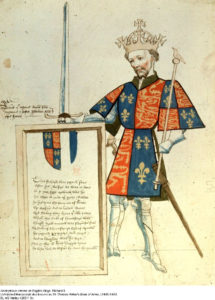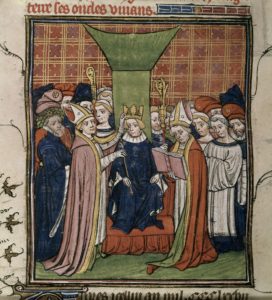
At first glance, one might not question the law of succession in England during the Middle Ages, but in reality the rules were open to interpretation, which is one reason the Wars of the Roses were fought with such intensity. As far back as King John, we see the youngest brother of a previous king mount the throne rather than the son of an elder brother (Arthur of Brittany—son of Geoffrey—should have ruled if the tradition of primogeniture were followed). Even Edward I, after the death of his three eldest sons, declared an order of succession that included his daughters. When it was Richard II’s turn, the issue was far from settled.
In 1376, Edward the Black Prince was dying. His child Richard, who was himself the second son (the first son Edward had died two years previously), was only nine years old. The Black Prince took nothing for granted, and on his deathbed he asked both his father and his brother John of Gaunt to swear an oath to protect Richard and uphold his inheritance. Even this precaution didn’t guarantee Richard’s patrimony, and Edward III felt obliged to create an entail that ordered the succession along traditional male lines. This meant that the Mortimers, descendants of Gaunt’s deceased elder brother Lionel (through his only daughter Philippa) were excluded. It also meant that John of Gaunt was next in line after Richard, and after him, Henry of Bolingbroke.
By this time, Edward III was an enfeebled old man and Gaunt had already started attending Parliament in his name. At this stage of his life, John of Gaunt was an overbearing, arrogant bully and he was incredibly unpopular. There were great fears—probably unfounded—that he would usurp the throne from his nephew; most historians believe that because of this, Edward III’s entail was not publicized. Presumably only the inner family and the great officers knew about its existence. After all, why inflame the public unnecessarily? If Richard were to sire an heir, the whole entail would be moot.

So the ten year-old Richard was crowned king; nobody wanted to take a chance on a less-than-secure regency. But this was not the end of the story. In the short run, of course, there was no reason to give the succession much thought. Richard married at age fifteen and his queen was only a year older than him. But after five or six years of infertility, it was beginning to look like there might be a problem. Queen Anne’s untimely death after twelve years of marriage and Richard’s subsequent espousal to the 8 year-old Isabella of France made it obvious that a child could not be expected for a long time—possibly never.
Many people, including our primary chroniclers of the period, took it for granted that the Mortimers were next in line for the throne. But Richard made no effort to show favor to Roger Mortimer, 4th Earl of March, nor did he make reference him to him as heir except possibly once in 1385 or 1386 (historians are not in agreement on this). When threatened with deposition, Richard could well have declared Roger his successor, a political ploy to remind his opponents that a 12 year-old would not rule any better than him. Although the Earl of March was well liked by the general population, after 1394 he seemed to have lost political clout. He moved to Ireland, where he served as Lieutenant mostly for the rest of his life. Roger was killed in a skirmish in 1398, leaving behind a seven year-old son. This effectively removed the Mortimers as candidates—for the time being—but they were destined to come back and haunt Henry IV in the rebellions of 1403 and 1405. (Also, their bloodline descended to Richard Plantagenet, 3rd Duke of York on his mother’s side.)
But even this wasn’t the end of the story. Richard was antagonistic toward John of Gaunt and this ill-will was transferred to his cousin Henry of Bolingbroke, especially after Henry joined the Lords Appellant and nearly cost him his throne in 1388. After the Appellant crisis, when Gaunt returned from Portugal, Richard received him joyfully back into the country; he had finally discovered that Gaunt’s presence was the only factor that kept his rebellious magnates at bay. In this time frame, by all indications, he restored Edward III’s entail and treated Gaunt as his heir—at least for the next five years.

But this favor did not extend to Bolingbroke. In 1394, as Richard was planning his expedition to Ireland, Gaunt petitioned Parliament to appoint Bolingbroke as Keeper of the realm. The Keeper was traditionally the heir to the throne, so Gaunt was fishing for a commitment. He couldn’t serve as Keeper himself because he was due to leave for the Aquitaine, so naturally Henry—next in line according to the entail—would take his place. However the Earl of March raised a strong objection, for he felt that he was heir apparent (it is possible he did not know about Edward III’s entail). Richard told them both to be silent and instead decided that his uncle Edmund of Langley, Duke of York (Gaunt’s younger brother) would be Keeper in his absence.
This was a whole new turn of events! Suddenly Gaunt was out and Edmund was in. From that point on, relations between Richard and the House of Lancaster began to sour. The King showered favors on his cousin, York’s son Edward, and created him Duke of Aumale. Whether Richard had intended to make York his heir, as Ian Mortimer concluded, remains speculation. If this was the case, it’s puzzling that Edmund defected to Bolingbroke, thus giving up his own—and his son’s—potential claim to the throne. Perhaps he had no inclination to be king; he was thought by many to be an indolent, irresolute fellow. Nonetheless, it was Edmund of Langley who fathered the House of York which proved so formidable in the Wars of the Roses.
Richard found it useful to keep everyone in suspense about the succession and never did proclaim a definite heir, though for the last several years he favored his fair-weather cousin Edward Duke of Aumale. When Bolingbroke invaded England, Aumale eventually went over to his side. That was the end of Edward’s possible aspirations!
After Richard’s usurpation, Henry IV chose to justify his claim—not by force of arms, but by citing his double descent from Henry III (through Edward III on his father’s side and Edmund “Crouchback”—younger son of Henry—on his mother’s side). Nonetheless, the Lancastrian line petered out in two generations, leaving the country ripe for a dynastic struggle—precipitated, many say, by the murder of the last true Plantagenet king.
In the end, could it be said that Richard II was usurped by his natural heir? He certainly wouldn’t have thought so! His reckless decision to disinherit Bolingbroke showed all the characteristics of personal enmity. Many historians think he was only waiting for Gaunt to drop dead before confiscating the Lancastrian inheritance and eliminating Henry’s influence forever. But he reckoned without his own unpopularity, and without Bolingbroke’s courage and decision. It’s ironic that the one person he strove so carefully to eliminate from the succession turned out to be the very man who destroyed his rule, his life, and his reputation.
FURTHER READING:
Bennett, Michael, Edward III’s Entail and the Succession to the Crown, 1376-1471, from “The English Historical Review, Vol. 113, no. 452 (June 1998), pp.580-609
Given-Wilson, Charles, Richard II, Edward II, and the Lancastrian Inheritance, from “The English Historical Review, Vol. 1009, No. 432 (June, 1994), pp.553-571
Mortimer, Ian, Richard II amd the Succession to the Crown, from “History”, Vol. 91, No. 3 (303) (July 2006), pp. 320-326